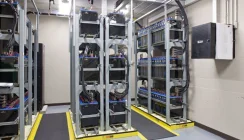How Lithium-Ion Batteries Will Change Datacentre UPS Installations
Lithium-ion batteries represent a technology that can disrupt the traditional data centre UPS market place and its reliance on valve regulated lead acid (VRLA) batteries. Other energy storage technologies have tried to disrupt this market place, including super capacitors and DC flywheels. The benefits of lithium-ion (li-ion) batteries mean that this new battery technology is rapidly gaining acceptance and disrupting other traditional industries including transportation and grid-scale energy storage.
Lithium-ion batteries offer several advantages over traditional lead acid UPS batteries. Li-ion batteries offer a longer working life time of up to 20 years, along with a reduced footprint and weight and far less requirements for cooling.
Aside from running costs, space is a big issue within a data centre and especially a co-location (Colo) installation. The larger the UPS system the greater the space required for the UPS and its battery set. VRLA batteries require a significant space and this can double for longer runtimes, parallel UPS installations and centralised UPS installations. Generally, the larger the UPS system the less available the space within the ‘white space’.
The lower the temperature within a server room or data centre the greater the spend on cooling and the electricity to drive this. Many installations are looking at raising their operational ambient temperatures to save on cooling and electricity costs. This move is based on recommendations from ASHRAE (the American Society of Heating, Refrigerating and Air-Conditioning Engineers) – see: https://tc0909.ashraetcs.org/documents/ASHRAE_TC0909_Power_White_Paper_22_June_2016_REVISED.pdf.
Traditional lead acid UPS installations require an ambient temperature of 20-25˚C and for every 1 degree rise above 30˚C the design life halves. Lithium-ion batteries can work up to 40˚C without degrading performance allowing the UPS to be used within a higher ambient working space alongside IT servers and without the need for additional cooling or a separate UPS and battery room.
Even if a lithium battery backed-up UPS system is installed as a centralised UPS system and requires its own room, the size of the battery installation will reduce by 50 to 75% compared to one using lead acid batteries. This is because of the power density associated with lithium-ion technologies. This benefit also impacts smaller single phase and three phase UPS installations within a server room, server rack or data centre row. The space saving allows the UPS to be installed nearer to the IT load, frees up more potential for revenue generating IT server racks with reduced cooling costs. Benefits that are ideal for small-to-medium-sized datacentres and can reduce electrical installation and infrastructure costs.
The benefits of lithium-ion batteries will also impact Edge computing and micro data centre adoption and their role out to support 5G technologies. With UPS systems being more compact and better able to work within higher ambient cabinets and with reduced cooling costs.
In addition lithium-ion batteries also impact modular UPS systems and allow for an easy integration and upgrade path. The space savings come into effect when plug-in battery modules are used within modular UPS frames that can scale both vertically and horizontally as required.
Li-ion batteries also have longer design lives than traditional valve regulated lead acid batteries. A typical VRLA battery in a UPS system may have a 5 year or 10-year design life meaning that it must be replaced within 3-4 or 7-8 years respectively. A lithium UPS battery can have a design life of 15-20 years. As well as requiring less replacement, a lithium UPS battery may also require less annual maintenance and testing. This is down to more advanced battery management required for a lithium-ion set.
Lead acid battery charging is a straight forward process and most UPS manufacturers use traditional techniques including a float charge to maintain energy and temperature compensated charging. UPS modules may also cycle, and the battery charger disconnect for UPS to 2 weeks (allowing the batteries to slowly self-discharge) to save energy and reduce battery wear and tear.
The traditional rule with a lead acid battery is to recharge to 80% within 24 hours. Lithium batteries can be recharged more rapidly within a 2-3 window and have almost unlimited charge/discharge cycles. A typical VRLA battery may be designed for around 300-400 cycles in comparison. Lithium batteries have a far higher ‘power density’ and their core material is more flammable and susceptible to hot-spots and the potential for thermal runaway. In terms of power density a typical lead acid battery may support an 80kVA UPS for 10 minutes runtime and the same physically sized lithium UPS battery offer even more power up to 200kVA for the same runtime period. Whilst lithium batteries themselves are constructed to prevent and contain an internal cell failure, it is vital that the battery management system is sophisticated enough to monitor across many more points within the lithium-ion installation and react accordingly in terms of power cut-off and isolation.
There is no doubt that lithium-ion UPS systems are already impact certain applications within the IT industry. Some of these are small such as EPoS terminals and other hard to access installations including CCTV, security and alarm systems which require battery back-up. For the server room or data centre some UPS manufacturers now offer single-phase UPS systems with a built-in li-ion battery and three phase UPS systems with either a standalone cabinet (for monoblock installations) and/or plug-in cartridges for three phase modular UPS systems.
As confidence in lithium-ion batteries grows and they become the standard energy source in other industries i.e. electric vehicles, overall prices will drop. We could one day see near to pricing parity with lead acid batteries rather than today’s premium of around 30%.


























